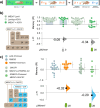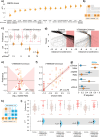Dopamine neurons that inform Drosophila olfactory memory have distinct, acute functions driving attraction and aversion
- PMID: 39556592
- PMCID: PMC11611264
- DOI: 10.1371/journal.pbio.3002843
Dopamine neurons that inform Drosophila olfactory memory have distinct, acute functions driving attraction and aversion
Abstract
The brain must guide immediate responses to beneficial and harmful stimuli while simultaneously writing memories for future reference. While both immediate actions and reinforcement learning are instructed by dopamine, how dopaminergic systems maintain coherence between these 2 reward functions is unknown. Through optogenetic activation experiments, we showed that the dopamine neurons that inform olfactory memory in Drosophila have a distinct, parallel function driving attraction and aversion (valence). Sensory neurons required for olfactory memory were dispensable to dopaminergic valence. A broadly projecting set of dopaminergic cells had valence that was dependent on dopamine, glutamate, and octopamine. Similarly, a more restricted dopaminergic cluster with attractive valence was reliant on dopamine and glutamate; flies avoided opto-inhibition of this narrow subset, indicating the role of this cluster in controlling ongoing behavior. Dopamine valence was distinct from output-neuron opto-valence in locomotor pattern, strength, and polarity. Overall, our data suggest that dopamine's acute effect on valence provides a mechanism by which a dopaminergic system can coherently write memories to influence future responses while guiding immediate attraction and aversion.
Copyright: © 2024 Mohammad et al. This is an open access article distributed under the terms of the Creative Commons Attribution License, which permits unrestricted use, distribution, and reproduction in any medium, provided the original author and source are credited.
Conflict of interest statement
The authors have declared that no competing interests exist.
Figures







References
-
- Darwin C. The Expression of the Emotions in Man and Animals. Project Gutenberg; 1899.
MeSH terms
Substances
LinkOut - more resources
Full Text Sources
Medical
Molecular Biology Databases
Research Materials

